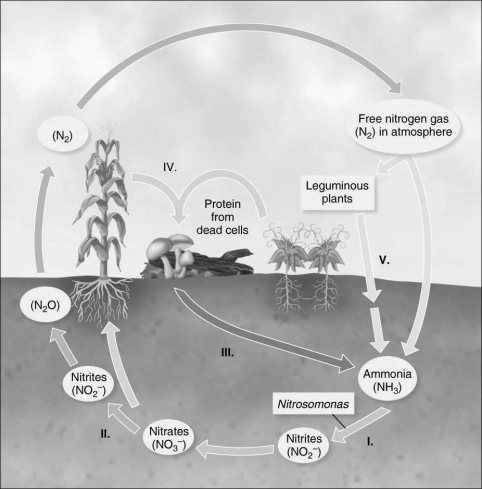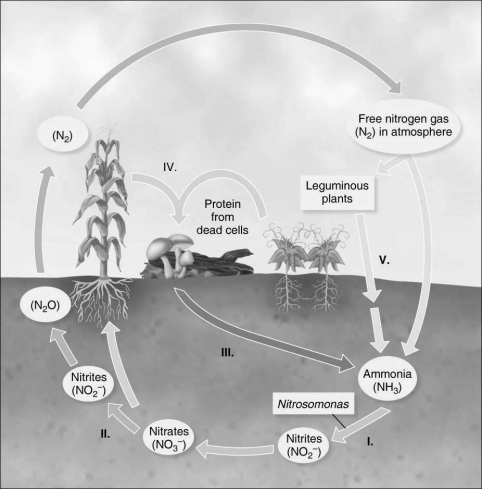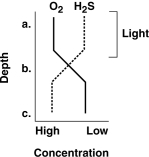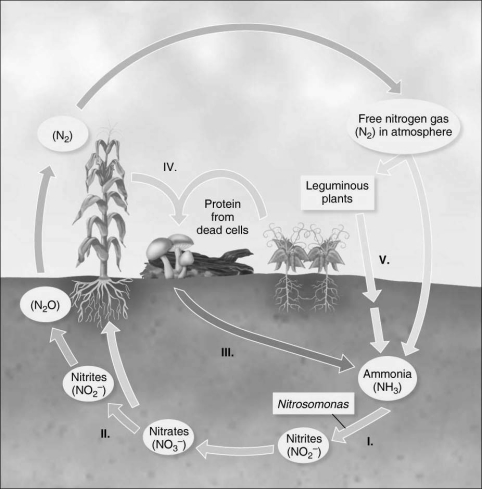A) carbonate
B) nitrate
C) phosphate
D) potassium
E) sulfate
G) B) and E)
Correct Answer

verified
Correct Answer
verified
Multiple Choice
Figure 27.1
 -Which term in Figure 27.1 describes step V?
-Which term in Figure 27.1 describes step V?
A) ammonification
B) dissimilation
C) denitrification
D) nitrification
E) nitrogen fixation
G) None of the above
Correct Answer

verified
Correct Answer
verified
Multiple Choice
Figure 27.1
 -Which step in Figure 27.1 represents anaerobic respiration?
-Which step in Figure 27.1 represents anaerobic respiration?
A) I
B) II
C) III
D) IV
E) V
G) C) and D)
Correct Answer

verified
Correct Answer
verified
Multiple Choice
Zoogloea form flocculent masses in
A) secondary sewage treatment.
B) water treatment.
C) tertiary sewage treatment.
D) anaerobic sludge digestion.
E) primary sewage treatment.
G) B) and D)
Correct Answer

verified
Correct Answer
verified
Multiple Choice
Untreated sewage is released into a river. Which of the following statements is FALSE?
A) The untreated sewage decreases the dissolved oxygen.
B) The untreated sewage is a health hazard.
C) The untreated sewage increases the BOD.
D) The untreated sewage kills bacteria.
E) All of the statements are true.
G) A) and D)
Correct Answer

verified
Correct Answer
verified
Multiple Choice
Figure 27.2
 -Where are photosynthetic bacteria most likely to be found in Figure 27.2?
-Where are photosynthetic bacteria most likely to be found in Figure 27.2?
A) a
B) b
C) c
D) a and b
E) b and c
G) B) and E)
Correct Answer

verified
Correct Answer
verified
Multiple Choice
Which of the following is an assimilation process?
A) Thiobacillus: H2S -S0
B) Photosynthetic bacteria: H2S -S0
C) Redwood tree: SO42- -Amino acids
D) Proteus: Amino acids -H2S
E) Desulfovibrio: SO42- -H2S
G) A) and B)
Correct Answer

verified
C
Correct Answer
verified
Multiple Choice
Which of the following is required for composting?
A) periodic turning or raking of the compost pile
B) addition of non- biodegradable materials
C) constant anaerobic conditions
D) addition of nitrogen and phosphorus sources
E) addition of thermophilic microbes
G) D) and E)
Correct Answer

verified
Correct Answer
verified
Essay
A newspaper headline reported "Algal Bloom Kills Fish." What actually caused fish death, given that the algae were not toxic? What could have caused the algal bloom?
Correct Answer

Answered by ExamLex AI
The fish death was actually caused by th...View Answer
Show Answer
Correct Answer
Answered by ExamLex AI
View Answer
Multiple Choice
Bacteria can increase the Earth's temperature by
A) providing nutrients for plant growth.
B) generating a great deal of heat in metabolism.
C) producing CH4, which is a greenhouse gas.
D) oxidizing CH4.
E) using the greenhouse gas CO2.
G) C) and D)
Correct Answer

verified
Correct Answer
verified
Multiple Choice
6H2S + 6CO2 light 6S0 + glucose 
A) takes place under aerobic conditions.
B) takes place under anaerobic conditions.
C) The amount of oxygen does not make any difference.
E) B) and C)
Correct Answer

verified
Correct Answer
verified
Multiple Choice
Aerobic respiration occurs in
A) tertiary sewage treatment.
B) anaerobic sludge digestion.
C) secondary sewage treatment.
D) water treatment.
E) primary sewage treatment.
G) A) and E)
Correct Answer

verified
Correct Answer
verified
Multiple Choice
Residual chlorine must be maintained in
A) anaerobic sludge digestion.
B) water treatment.
C) primary sewage treatment.
D) secondary sewage treatment.
E) tertiary sewage treatment.
G) A) and C)
Correct Answer

verified
Correct Answer
verified
Multiple Choice
Which of the following is mismatched?
A) SO42- + 10H+ -H2S + 4H2O - Desulfovibrio
B) 6CO2 + 6H2O -C6H12O6 + 6O2 - Clostridium
C) N2 + 6H+ -2NH3 - Beijerinckia
D) CO2 + 4H2 -CH4 + 2H2O - Methane- producing bacteria
E) Fe2+ -Fe3+ - Thiobacillus ferrooxidans
G) B) and C)
Correct Answer

verified
Correct Answer
verified
Multiple Choice
Which of the following requires aerobic conditions?
A) water treatment
B) secondary sewage treatment
C) nitrogen fixation
D) sludge digestion
E) primary sewage treatment
G) A) and C)
Correct Answer

verified
Correct Answer
verified
Multiple Choice
Figure 27.1
 -Which of the following terms describes step III in Figure 27.1?
-Which of the following terms describes step III in Figure 27.1?
A) nitrogen fixation
B) nitrification
C) assimilation
D) denitrification
E) ammonification
G) A) and E)
Correct Answer

verified
Correct Answer
verified
True/False
The water from tertiary sewage treatment can be used as drinking water.
B) False
Correct Answer

verified
Correct Answer
verified
True/False
In small communities lacking municipal sewage systems, sewage is treated in septic systems or oxidation ponds.
B) False
Correct Answer

verified
True
Correct Answer
verified
True/False
Microorganisms in deep- sea vents and caves serve as autotrophic primary producers in the absence of sunlight.
B) False
Correct Answer

verified
Correct Answer
verified
Multiple Choice
All of the following organisms are involved in carbon fixation EXCEPT
A) green and purple sulfur bacteria.
B) mycorrhizae.
C) cyanobacteria.
D) algae.
E) lichens.
G) A) and E)
Correct Answer

verified
B
Correct Answer
verified
Showing 1 - 20 of 57
Related Exams